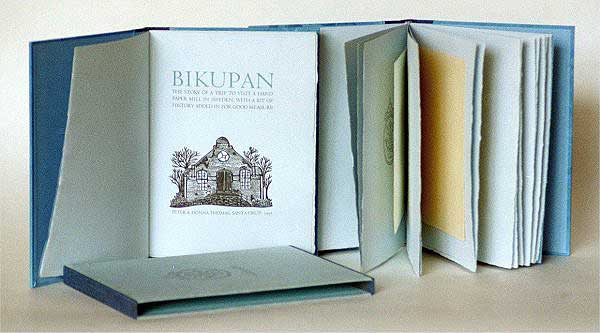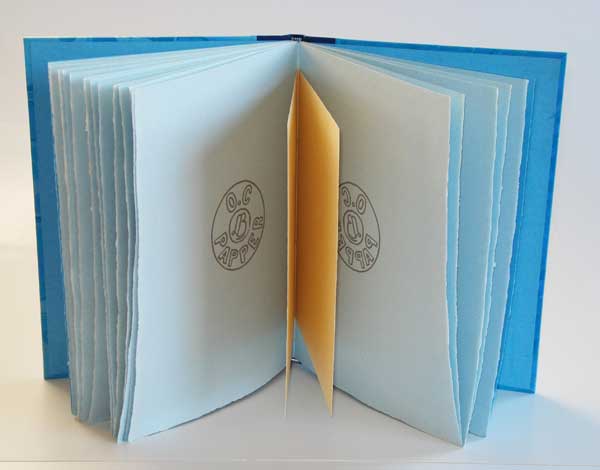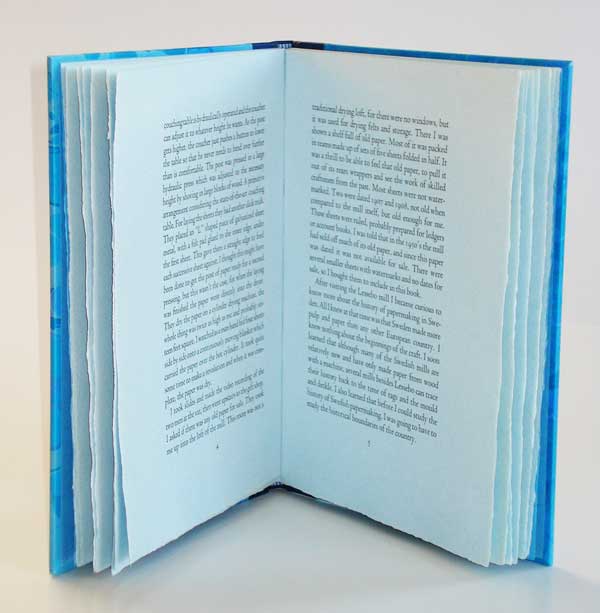PETER & DONNA THOMAS
![]() 260 Fifteenth Avenue Santa Cruz CA 95062 (831)
831-515-2757
260 Fifteenth Avenue Santa Cruz CA 95062 (831)
831-515-2757
| About the Artists | Contact & Ordering Information |
||||
| Articles and Essays | Hand Papermaking | Classes &
Exhibits |
Home |
PETER & DONNA THOMAS
![]() 260 Fifteenth Avenue Santa Cruz CA 95062 (831)
831-515-2757
260 Fifteenth Avenue Santa Cruz CA 95062 (831)
831-515-2757
| About the Artists | Contact & Ordering Information |
||||
| Articles and Essays | Hand Papermaking | Classes &
Exhibits |
Home |

A69. Peter Thomas. Bikupan. Santa Cruz: Peter & Donna Thomas, 1992. 10.5 x 7.625 inches, 60 pages, 119 copies.
Binding: Quarter bound in leather and blue marbled paper over boards. Title in gold on spine. Endsheets dark blue. Some copies housed in a slipcase covered in blue book cloth and blue paper handmade by Peter. Paper: Blue, handmade by Peter in 1983. Printing: Letterpress; some illustrations printed from metal engravings. Typography: Monotype and handset Centaur and Arrighi; title and half title in blue. Illustration: Opening initial, one linoleum cut of the mill building one decorated initial letter on opening page, and line drawing reproductions of watermarks by Donna. Six samples of paper made at the Lessebo Paper Mill tipped-in. Note: The page count includes 9 folios sheets of text paper and 6 folio sheets of gelatin sized watermarked vintage paper made at the Lessebo in the early 20th century. The text combines research by Henk Voorn about the history of papermaking in Sweden, an essay by Bo Rudin about the history of the Lessebo paper mill, and my journal entries documenting my visit to the mill. The Lessebo mill in Sweden was at the time one of the few remaining traditional hand paper mills in the world. It was open to visitors during the summer months and offered daily guided tours. We arrived after the end of the season. They still allowed visitors, but there were no tours. The day I visited, there were two men working at the vat making a medium-size sheet of paper. I asked them questions, but they did not speak English. I spent an hour taking slides and made the video recording of them at the vat, then went upstairs to the gift hop. I asked if there was any old paper for sale. They took me up into the loft of the mill. There I was shown a shelf full of old paper. Most of it was packed in reams made up of sets of five sheets folded in half. It was a thrill to be able to feel that wonderful old, gelatin-sized paper, to pull it out of its ream wrappers and see the work of skilled craftsmen.
Here is a excerpt from the text: We arrived at lunch time and they were closed. Undaunted we made sandwiches and waited. The mill is a beautiful old building standing right next to a giant modern pulp and paper mill. It is painted yellow and brown, and the architecture makes it look somewhat like the beehive which is used as a watermark in some types of paper made there. Dard Hunter wrote about the Lessebo mill saying: "This fine type of permanent mill construction is found in all handmade paper mills of Europe. For the most part the modern European handmade paper mills are not the decayed remnants of the pre-machine industry, but these establishments are housed in substantial buildings with well-made efficient equipment." I climbed around the mill race where the old water turbines lay rusting. The water was dirty and smelled from the machine mill's runoff. Lunch must have been over for they opened the doors and I went inside. The hollander beaters and a gift shop are on the ground level and the vats in a room below. Their equipment is a beautiful maze of machinery. The stuff chest is a huge wooden barrel connected by a pipe to a wooden race crossed with ridges which are designed to act as dirt traps. This connects to the knotter, a rattling old gizmo of the slotted plate variety, which the workers always turned off as soon as possible because it was so loud. The pulp flows from the knotter into a drum washer section just beside the vat. This recycles the water through the dirt trap. The vat has a unique sort of "hog" for agitation. It is a rake-like contraption which is submerged in the vat and is moved up and down through the water by an amazing arrangement of hinges and levers. The day I visited there were two men working at the vat, making a medium size sheet of paper. Their mould seemed to be falling apart, but it could have been a design unique to this mill. It was so flexible I wondered how they could do anything with it at all. And the deckle used at Lessebo is different than a typical English one. It has wooden strips on the back and half way down each side. These are covered by the brass trim. Neither of the workers spoke English so I watched in silence.

